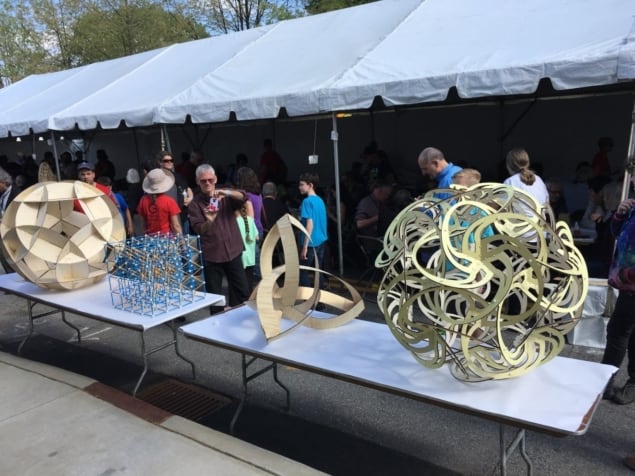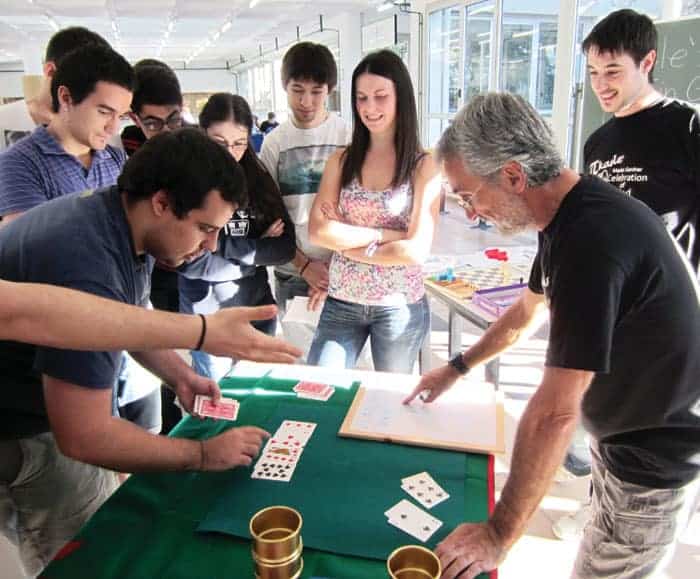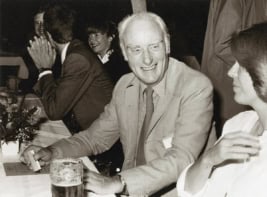Juggling, knitting and solving the Rubik’s cube – Robert P Crease reports on highlights from the 13th “G4G” conference in honour of mathematics popularizer Martin Gardner

When Roxana started to juggle balls with her feet it was proof, if any were needed, that G4G is the most disciplinarily diverse conference around.
G4G, or “Gathering for Gardner”, is a biennial event in honor of the recreational mathematician Martin Gardner (1914–2010). As a columnist for Scientific American, Gardner inspired generations of physicists, mathematicians, philosophers, puzzle-makers, logicians, magicians and others, including me. The 13th gathering this past weekend was called G4G13.
The conference began last Wednesday in the usual fashion: early-bird registrants flocked to the bar at the Ritz-Carlton in downtown Atlanta to show their favourite mathematics, physics, logic and magic tricks. These are called “bar bets”, for their only practical purpose is to give you cool ways to try to win money off sceptical strangers. I saw some classics on Wednesday, such as the challenge to guess whether a red wine glass is taller than its circumference – as a stranger is likely to think – or shorter, as it almost always is. The events of the next four days shared the same spirit, combining learning about the world with a spirit of playfulness – linked wherever possible to the number 13.
Gardner’s special skill was to get people to enjoy maths by acquainting them with the pleasure of solving problems in areas that ranged from physics to card playing and magic. About 120 talks were given – almost all a mere six minutes long, and each delivered to the entire gathering. We learned about such things as mathematical knitting, hyperbolic tiling patterns, the physics of dice and tops, fine points of logic, and pseudoscience. One celebrity participant was the 2014 Fields medallist Manjul Bhargava. Another was Erno Rubik, the Hungarian inventor of the eponymous cube that in the 1980s became the bestselling toy of all time.
Many attendees were inspired by Gardner’s columns when they first appeared between 1956 and 1981, while others, including Dominika Vasilkova, a third-year undergraduate physics student at Imperial College, London, learned of Gardner after his death through his 100+ books. Gabriel Kanarek, an eight-year-old first-time participant, spoke about properties of numerical sequences, while the 101-year-old British mathematician Richard K Guy had a video played about his life and work. The presence of a few infants meant that the lifetimes of G4G13’s vocal contributors spanned over a century.
Between talks, participants were treated to juggling, rope tricks, physics puzzles, and a virtual reality demonstration of hyperbolic space. James Gardner, Martin’s son, told anecdotes about his father. Rubik signed cubes.
On Friday participants assembled a series of mathematical sculptures. One, by the Danish woodcarver Bjarne Jespersen, made a dramatic entry. Virgin Airlines had lost his luggage, which contained the pieces to his sculpture, but recovered and delivered it just in time. I helped assemble “Knotted Cube”, as he called his sculpture, which illustrates what might happen if two ends of a cube passed through each other. “It’s a cube that had an accident in the fourth dimension,” one passer-by noted.
Late that evening, another attendee taught us how to find the schedules of astronomical events through sites like Heavens Above. Seeing that the International Space Station (ISS) was about to pass that part of the sky, several of us rushed outside just in time to catch the ISS glide between several of Atlanta’s skyscrapers. It was a Gardner moment, in which just a little bit of scientific knowledge and inquiry allows you to connect better with the world and enjoy its visible wonders.

One G4G tradition is for a pair of participants to play “Dr Matrix”, a fictional character whom Gardner invented to spoof numerology. In a point–counterpoint duel, one Dr Matrix proves the positive power of the conference number in the universe, while the other proves that it is the root of all evil. I played “Dr Matrix pro-13”, pointing to the number’s patriotic role (the 13 original US colonies), its morality (the 13th Amendment to the US Constitution abolished slavery), its role as a glass ceiling-breaker (the 13th Doctor Who is the first female doctor), its maths contributions in the Fibonacci series and as the first emirp (a number that’s a prime backwards and forwards), etc. British mathematician Colin Wright, as “Dr Matrix anti-13”, then had the audience roaring with laughter in demolishing my claims and revealing 13 to be an “insufficiently maligned” number.

Celebrating the mind
The after-dinner entertainment at the Saturday night banquet began with a set of jaw-dropping magic shows. These included a spectacular performance by the Russian acrobat Roxana Küwen in which she juggled several balls with her feet. Inspired by Roxana, conference participant Sydney Weaver, one of the world’s leading female Rubik’s Cube solvers, then came onstage to use her feet to solve a Rubik’s cube. Two other participants attempted to recreate Roxana’s patterns using conventional hand juggling, and discovered that it was much harder than it looked.
Martin Gardner would have smiled.



